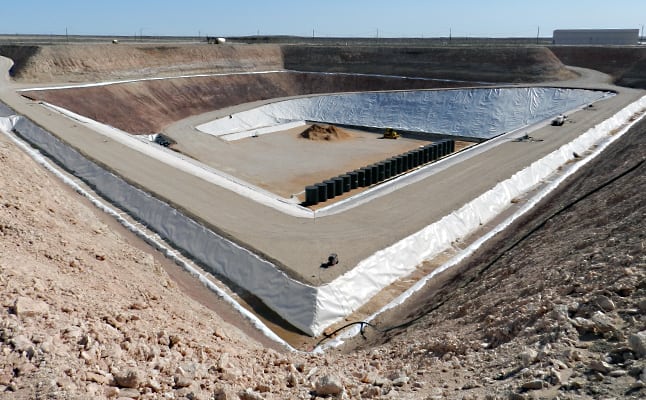Texas Consolidated Nuclear Waste Storage Facility to Be Revived
Waste Control Specialists (WCS) and Orano USA intend to revive licensing of a consolidated interim storage facility (CISF) in Andrews County, Texas, where spent nuclear fuel (SNF) from reactors across the country can be stored until a permanent repository is developed.
The companies said on March 13, 2018, they intend to form a joint venture that will ask the Nuclear Regulatory Commission (NRC) to resume its review of the CISF license application, which WCS originally submitted in April 2016. In that application, WCS requested NRC authorization to store up to 5,000 metric tons of uranium for a period of 40 years at its Texas Compact Waste facility.
In April 2017, however, the company requested that the NRC temporarily suspend all safety and environmental review activities as well as public participation activities associated with the license application. The company cited “a magnitude of financial burdens” that made pursuit of licensing unsupportable.
One issue was that the NRC’s estimate of the cost of the application review—$7.5 million—was “significantly higher” than WCS originally estimated. Costs associated with a public participation process and a potential adjudicatory hearing were also estimated to be “considerable.” WCS also said a cost-sharing agreement it had in place with one of its partners was “depleted” and it could not be “extended.” At the same time, WCS has faced significant operating losses in each of its operating years, and the cost of actively pursuing the project only serves to increase those losses, it said.
WCS said on its website in March that a joint venture with Orano USA—formerly AREVA Nuclear Materials—would leverage the French company’s decades of expertise in used fuel packaging, storage, and transportation. Scott State, CEO of WCS, noted that WCS’s proposed solution was an “industry-driven near-term solution” that will use “proven storage technology and procedures to expand the capabilities and operations at the WCS site to include consolidated interim storage of commercial used nuclear fuel.” Sam Shakir, CEO of Orano USA, in a statement said the WCS-Orano USA joint venture “will provide safety, flexibility and value for used nuclear fuel titleholders and reduce U.S. taxpayer liabilities for ongoing storage, while plans for a permanent federal repository continue.”
WCS’s Texas Compact Waste Facility in western Andrews County has been operational since early 2012. Owned and licensed by the State of Texas, it is the only commercial facility in the U.S. licensed in the past 40 years to dispose of Class A, B, and C low-level radioactive waste. It primarily serves Texas and Vermont, which are member states of the Texas Compact Commission, but it is also available to 34 other U.S. states that have no access to a compact disposal facility. However, irradiated SNF discharged from commercial nuclear reactors is classified as high-level radioactive waste.

A Boost for Consolidated Interim Storage
As POWER reported, the nation lacks a long-term nuclear waste strategy, and nearly a third of the nation’s SNF is in dry storage in about 2,080 cask or canister systems at 75 reactor sites scattered across 33 states. U.S. SNF pools have reached capacity limits, forcing nuclear generators to load about 160 new dry storage canisters each year.
Nuclear generators currently recover costs for SNF storage and management by suing the Department of Energy (DOE), which, under the Nuclear Waste Policy Act (NWPA), was contractually obligated to dispose of SNF by January 1998. The DOE, however, cannot fulfill its obligation because no permanent repository exists—or is even in sight. (For an in-depth look at the current state of nuclear waste management, see “A Break in the Nuclear Waste Impasse?” in POWER’s March 2018 issue.)
Beyond Yucca Mountain—the long-stonewalled Nevada repository identified by amendments to the NWPA in 1987—the law allows for only two other nuclear waste options: to build one or more interim storage facilities to temporarily consolidate SNF across the nation until a permanent repository is completed; or use federally monitored retrievable storage (MRS) facilities, in which the DOE could store nuclear waste from commercial nuclear plants pending permanent disposal or reprocessing.
While no MRS facilities have been proposed to date, only two private companies have filed NRC applications for an interim spent facility: WCS and Holtec, a Camden, New Jersey–based supplier of SNF management equipment.
Holtec Gains Recognition
Earlier this month, the NRC affirmed acceptance review of Holtec’s March 2017-submitted license application for its proposed CISF in Lea County, New Mexico, which it calls “HI-STORE CIS.” The NRC said it could issue a 40-year license by July 2020 or earlier for the CISF that could store up to 10,000 canisters in the below-ground storage system.
On March 26, Holtec International reported that its HI-STAR 100MB cask, which could serve to transport hundreds of multipurpose canisters in storage across the U.S. to its proposed HI-STORE CIS facility in New Mexico, won an international competition for deployment in China.
Holtec’s vice president of Business Development, Joy Russell, said in a statement on March 12 that Holtec’s HI-STAR transportation systems have been used for 12 years now. In 2006, the 1976-closed Humboldt Bay Power Plant south of Eureka, California, became the first plant to feature subterranean storage. Ameren’s Callaway plant deployed the first canister based on Holtec’s HI-STORM UMAX storage system, which it plans to use at the New Mexico CISF. In January 2018, a seismically hardened version of the HI-STORM UMAX canister was lowered into a fortified cavity at the San Onofre nuclear plant.
“The successful deployment of under-ground-storage technology and Holtec’s actions licensing the HI-STORE CIS facility are true demonstrations that consolidated interim storage is achievable,” Russell said.
—Sonal Patel is a POWER associate editor (@sonalcpatel, @POWERmagazine)